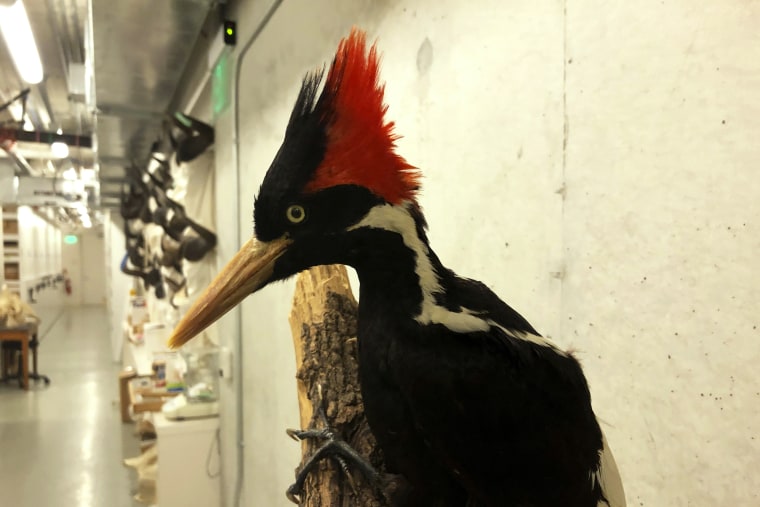The U.S. government is ringing the death knell for 23 species of birds, fish and other wildlife, including the splendid ivory-billed woodpecker.
The U.S. Fish and Wildlife Service will officially declare the "Lord God Bird" extinct Wednesday after years of unconfirmed sightings and fruitless searches in the South.
The rare decision to remove more than 20 species from the endangered list forewarns the devastating impact climate change and habitat loss will have on global biodiversity, threatening many other animals and plants with extinction, federal officials said.
The factors behind the disappearances vary — too much development, water pollution, logging, competition from invasive species, birds killed for feathers and animals captured by private collectors. In each case, humans were the ultimate cause. Only 11 species have previously been removed because of extinction in the almost half-century since the Endangered Species Act was signed into law. Wednesday's announcement kicks off a three-month comment period before the species status changes become final.
Around the globe, 902 species have been documented as extinct. The actual number is thought to be much higher, because some are never formally identified, and many scientists warn that the Earth is in an "extinction crisis," with flora and fauna disappearing at 1,000 times the historical rate.
It's possible that one or more of the 23 species in Wednesday's announcement could reappear, several scientists said.
A leading figure in the hunt for the ivory-billed woodpecker said it was premature to call off the effort after millions of dollars have been spent on searches and habitat preservation efforts.
"Little is gained and much is lost" with an extinction declaration, said Cornell University bird biologist John Fitzpatrick, lead author of a 2005 study that claimed that the woodpecker had been rediscovered in eastern Arkansas.
"A bird this iconic and this representative of the major old-growth forests of the Southeast, keeping it on the list of endangered species keeps attention on it, keeps states thinking about managing habitat on the off chance it still exists," he said.
The International Union for Conservation of Nature, a Switzerland-based group that tracks extinctions globally, isn't putting the ivory-billed woodpecker into its extinction column because it's possible the birds still exist in Cuba, said Craig Hilton-Taylor, head of the organization's "red list unit."
Hilton-Taylor said there can be unintended but damaging consequences if extinction is declared prematurely. "Suddenly the [conservation] money is no longer there, and then suddenly you do drive it to extinction because you stop investing in it," he said.
Federal officials said the extinctions declaration was driven by a desire to clear a backlog of recommended status changes for species that hadn't been acted upon for years. They said it would free up resources for on-the-ground conservation efforts for species that still have a chance for recovery.
What's lost when such efforts fail are creatures often uniquely adapted to their environments. Freshwater mussel species like the ones the government says have gone extinct reproduce by attracting fish with lure-like appendages, then send out clouds of larvae that attach to gills of fish until they've grown enough to drop off and live on their own.
The odds are slim against any mussel's surviving into adulthood — a 1-in-a-million chance, said Ford of the wildlife service — but those that do can live a century or longer.
Hawaii has the most species on the list — eight woodland birds and one plant. That's in part because the islands have so many plants and animals that many have extremely small ranges and can blink out quickly.
The most recent to go extinct was the teeny po'ouli, a type of bird known as a honeycreeper discovered in 1973.
By the late 1990s just three remained — a male and two females. After failures to mate them in the wild, the male was captured for potential breeding and died in 2004. The two females were never seen again.
The fate of Hawaii's birds helped push Duke University extinction expert Stuart Pimm into his field. Despite the grim nature of the government's proposal to move more species into the extinct column, Pimm said, the toll would probably have been much higher without the Endangered Species Act.
"It's a shame we didn't get to those species in time, but when we do, we are usually able to save species," he said.
Since 1975, 54 species have left the endangered list after having recovered, including the bald eagle, the brown pelican and most humpback whales.
Climate change is making species' recovery harder, bringing drought, floods, wildfires and temperature swings that compound the threats they already faced.
How they are saved is also changing. No longer is the focus on individual species, let alone individual birds. Officials say the broader goal now is to preserve their habitats, which boost species of all types that live there.
"I hope we're up to the challenge," said biologist Michelle Bogardus of the wildlife service in Hawaii. "We don't have the resources to prevent extinctions unilaterally. We have to think proactively about ecosystem health and how do we maintain it given all these threats."

